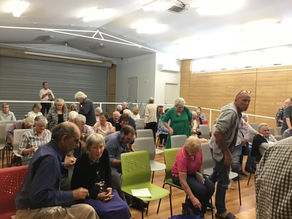YDHS Friday talk
January 2025
Tom Gara—Aboriginal people on the Southern Fleurieu Peninsula
Yankalilla Library Main Hall
Tom has published papers on Kaurna people and conducted research for the Kaurna Native Title claim while at the Attorney General’s Department. On 25 January he spoke at a Yankalilla and District Historical Society Friday talk at the Yankalilla Library.
Colonel William Light, who reached Kangaroo Island in August 1836 on the ‘Rapid’, left a party at Rapid Bay before sailing north to find a settlement site. Journals of surveyor B.T. Finniss and surgeon John Woodforde of the Rapid Bay party reveal that the indigenous people they met were from Kangaroo Island (women from Tasmania and the mainland), Cape Jervis and Encounter Bay.
The first feast for Aboriginal people was held by Governor Gawler in October 1838 and three ‘chiefs’ were present: ‘King Rodney’ from the Aldinga area, ‘Captain Jack’ from the north and ‘King John’ from the Willunga-Myponga area. Missionaries Schurmann and Teichelmann recorded Kaurna language, law and customs and Protector of Aborigines, Matthew Moorhouse, determined while talking to the ‘chiefs’, that territorial rights followed the male line.
Tom explained how it came to pass that Aboriginal people from the south were believed to be called Kaurna. Norman Tindale, ethnographer at the SA Museum, did fieldwork and research from the 1920s to 1940s which led to a map of Australian tribal boundaries being published in 1974. His map showed Kaurna country extending from Cape Jervis to Crystal Brook, based on information he obtained from interviews with Ivaritji, daughter of ‘King Rodney’ and Clarence Long (Milerum) in the 1920s and 1930s. Tindale believed the correct name for the Adelaide tribe was Kaurna, but that name was only recorded once in the historical sources, where it was used to refer to ‘Encounter Bay Bob’s tribe’. The term ‘Kaurna’ may be derived from the Ngarrindjeri term korna, the word used by that group for ‘man’ or ‘people’.
In the 1940s, anthropologists R. & C. Berndt interviewed Ngarrindjeri people at Murray Bridge and they gave different versions of boundaries and languages.
Tom gave examples from journals of Yankalilla district settlers, Henry Kemmis and G.P. Wilkinson, of Aboriginal people visiting or living in the district. They came for paid work, for fishing and hunting, and to fend off destitution by staging corroborees and boomerang exhibitions. The Solomons of Stock Yards and the Tripps from Encounter Bay are examples of Aboriginal people who survived during this time.



